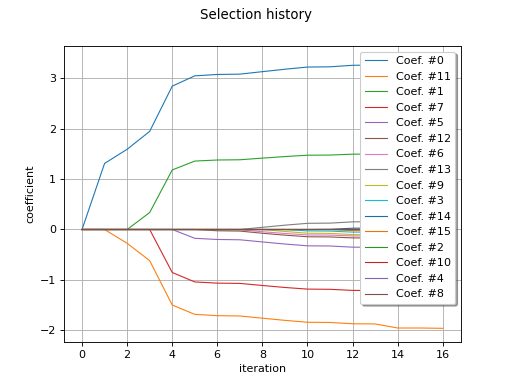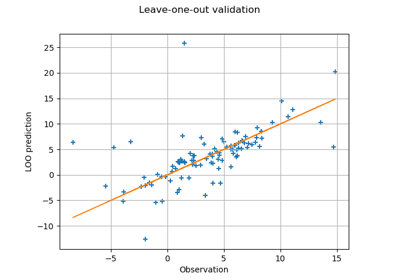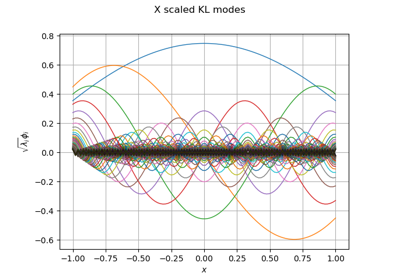LARS¶
(Source code, png)

- class LARS(*args)¶
Least Angle Regression.
Refer to Sparse least squares polynomial metamodel.
See also
Notes
LARS inherits from
BasisSequenceFactory.If the size
of the PC basis is of similar size to
, or even possibly significantly larger than
, then the following ordinary least squares problem is ill-posed:
The sparse least squares approaches may be employed instead. Eventually a sparse PC representation is obtained, that is an approximation which only contains a small number of active basis functions.
Examples
>>> import openturns as ot >>> from openturns.usecases import ishigami_function >>> im = ishigami_function.IshigamiModel() >>> # Create the orthogonal basis >>> polynomialCollection = [ot.LegendreFactory()] * im.dim >>> enumerateFunction = ot.LinearEnumerateFunction(im.dim) >>> productBasis = ot.OrthogonalProductPolynomialFactory(polynomialCollection, enumerateFunction) >>> # experimental design >>> samplingSize = 75 >>> experiment = ot.LowDiscrepancyExperiment(ot.SobolSequence(), im.distributionX, samplingSize) >>> # generate sample >>> x = experiment.generate() >>> y = im.model(x) >>> # iso transfo >>> xToU = ot.DistributionTransformation(im.distributionX, productBasis.getMeasure()) >>> u = xToU(x) >>> # build basis >>> degree = 10 >>> basisSize = enumerateFunction.getStrataCumulatedCardinal(degree) >>> basis = [productBasis.build(i) for i in range(basisSize)] >>> # run algorithm >>> factory = ot.BasisSequenceFactory(ot.LARS()) >>> factory.setVerbose(True) >>> seq = factory.build(u, y, basis, list(range(basisSize)))
Methods
build(x, y, psi, indices)Run the algorithm.
Accessor to the object's name.
getId()Accessor to the object's id.
Accessor to the stopping criterion on the L1-norm of the coefficients.
getName()Accessor to the object's name.
Accessor to the object's shadowed id.
Accessor to the object's visibility state.
hasName()Test if the object is named.
Test if the object has a distinguishable name.
setMaximumRelativeConvergence(coefficientsPaths)Accessor to the stopping criterion on the L1-norm of the coefficients.
setName(name)Accessor to the object's name.
setShadowedId(id)Accessor to the object's shadowed id.
setVisibility(visible)Accessor to the object's visibility state.
getVerbose
setVerbose
- __init__(*args)¶
- build(x, y, psi, indices)¶
Run the algorithm.
- Parameters:
- x2-d sequence of float
Input sample
- y2-d sequence of float
Output sample
- psisequence of
Function Basis
- indicessequence of int
Current indices of the basis
- Returns:
- measure
BasisSequence Fitting measure
- measure
- getClassName()¶
Accessor to the object’s name.
- Returns:
- class_namestr
The object class name (object.__class__.__name__).
- getId()¶
Accessor to the object’s id.
- Returns:
- idint
Internal unique identifier.
- getMaximumRelativeConvergence()¶
Accessor to the stopping criterion on the L1-norm of the coefficients.
- Returns:
- efloat
Stopping criterion.
- getName()¶
Accessor to the object’s name.
- Returns:
- namestr
The name of the object.
- getShadowedId()¶
Accessor to the object’s shadowed id.
- Returns:
- idint
Internal unique identifier.
- getVisibility()¶
Accessor to the object’s visibility state.
- Returns:
- visiblebool
Visibility flag.
- hasName()¶
Test if the object is named.
- Returns:
- hasNamebool
True if the name is not empty.
- hasVisibleName()¶
Test if the object has a distinguishable name.
- Returns:
- hasVisibleNamebool
True if the name is not empty and not the default one.
- setMaximumRelativeConvergence(coefficientsPaths)¶
Accessor to the stopping criterion on the L1-norm of the coefficients.
- Parameters:
- efloat
Stopping criterion.
- setName(name)¶
Accessor to the object’s name.
- Parameters:
- namestr
The name of the object.
- setShadowedId(id)¶
Accessor to the object’s shadowed id.
- Parameters:
- idint
Internal unique identifier.
- setVisibility(visible)¶
Accessor to the object’s visibility state.
- Parameters:
- visiblebool
Visibility flag.
Examples using the class¶

Compute leave-one-out error of a polynomial chaos expansion
 OpenTURNS
OpenTURNS



